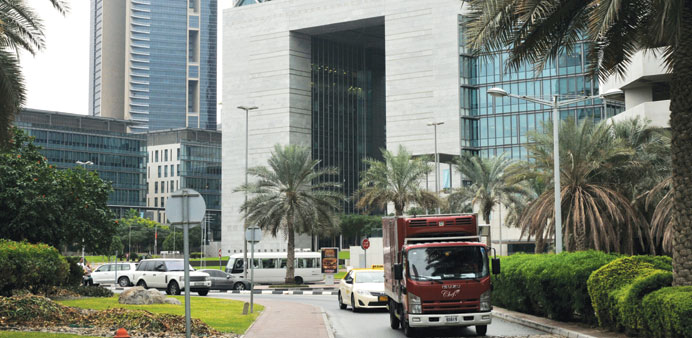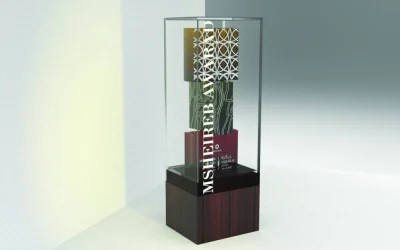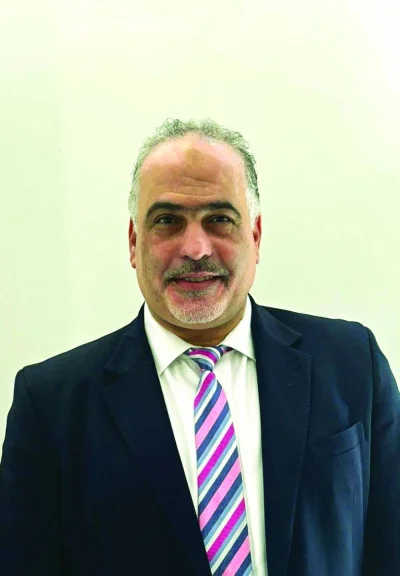A truck and taxi drive past the Dubai International Financial Centre. The centre is pivoting East as the Western banking industry grapples with rising capital requirements, regulatory scrutiny and fines and slower growth in the aftermath of the global financial crisis.
Bloomberg/Dubai
The Dubai International Financial Centre spent the first 10 years of its existence looking to banks in the West. It’s planning to spend the next decade looking East.
DIFC, as the tax-free business park is called, became the Middle East’s biggest financial centre by attracting the regional offices of western banks such as Goldman Sachs Group and Citigroup. The 110-acre centre is now seeking to triple the number of its financial firms to 1,000 by 2024, relying mainly on Asian and African institutions using Dubai as a hub to expand, governor Essa Kazim said in Dubai recently.
The centre is pivoting East as the Western banking industry grapples with rising capital requirements, regulatory scrutiny and fines and slower growth in the aftermath of the global financial crisis. HSBC Holdings has last week announced it plans to cut 25,000 jobs globally and sell businesses in Brazil and Turkey, while Standard Chartered and Deutsche Bank have both replaced their leadership this year.
“The western financial institutions are in retreat since the financial crisis, so if you are going to have growth it has to come from the East,” from Asia and Africa, Nasser Saidi, an adviser and former chief economist at the DIFC, said by phone on June 14. “You have to be the hub for emerging markets.”
DIFC, set up in 2004, is also aiming to increase the overall workforce to 50,000 from 17,860 and boost assets under management to $250bn from $10.4bn.
Half the new growth is expected to come from financial institutions from developing countries using Dubai as a gateway to tap markets in South Asia, the Middle East and Africa, which has a combined gross domestic product of $7.9tn, DIFC said. These will be in activities such as trade and project finance, capital markets, asset management and reinsurance.
“We really believe that the next phase of growth will be from India, China, the Asia-Pacific, so that will really be our focus,” Kazim said while unveiling DIFC’s 10-year strategy. “The market dynamics change and we need to react to that.”
A DIFC team led by Kazim will be visiting Beijing and Shanghai in September in a bid to attract more companies to the centre. Currently, 48% of the financial services companies in the DIFC come from North America and Europe, 30% from the Middle East and 11% from Asia.
Some of China and India’s biggest banks have already set up shop in the DIFC, including Agricultural Bank of China Ltd and China Construction Bank Corp. State Bank of India and ICICI Bank Ltd, India’s two biggest banks, also have units.
China and India will probably be among the world’s fastest growing major economies this year, with GDP growth of about 7%, according to data compiled by Bloomberg.
Dubai and its state-owned companies borrowed more than $100bn to develop its property industry and transform into a tourism and financial services hub and was pushed to the brink of a default by the financial crisis. It has built the world’s tallest skyscraper and the biggest shopping mall, although it has limited success with some ventures such as developing its NASDAQ Dubai market in the DIFC as a regional stock exchange.
Still, the importance of western financial institutions is not going to disappear entirely for the DIFC, ranked 23rd among global financial centres by the Global Financial Centres Index. Thirty percent of the growth over the next decade will come from existing companies expanding activities in banking and capital markets and the centre will also seek to attract more mid-size asset managers and reinsurance firms.
Twenty one of the world’s 25 biggest banks and 11 of the top 20 money managers already have offices in the DIFC.
“If the dynamic shifts again toward North America and Europe, we will shift our strategy,” Kazim said. “A majority of them are already here and we would really like to facilitate and help them grow here.”



